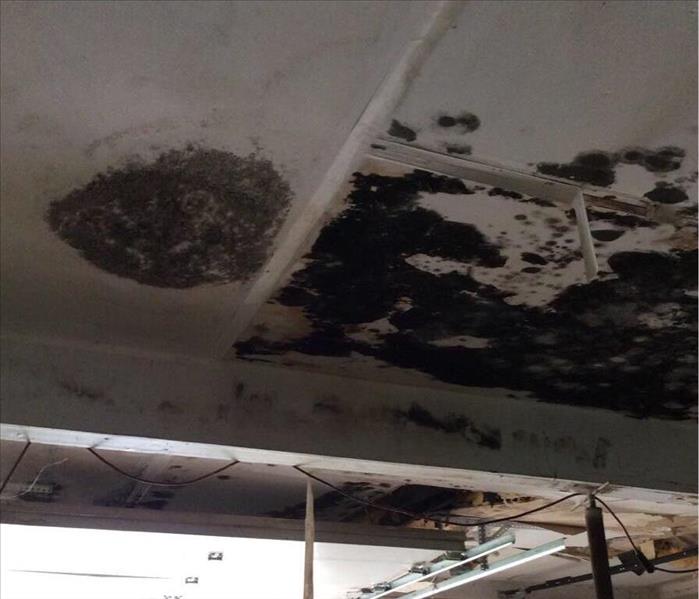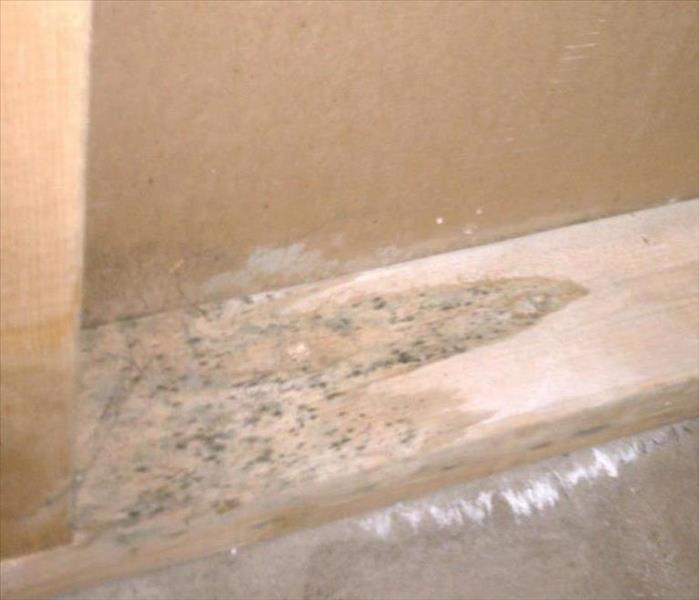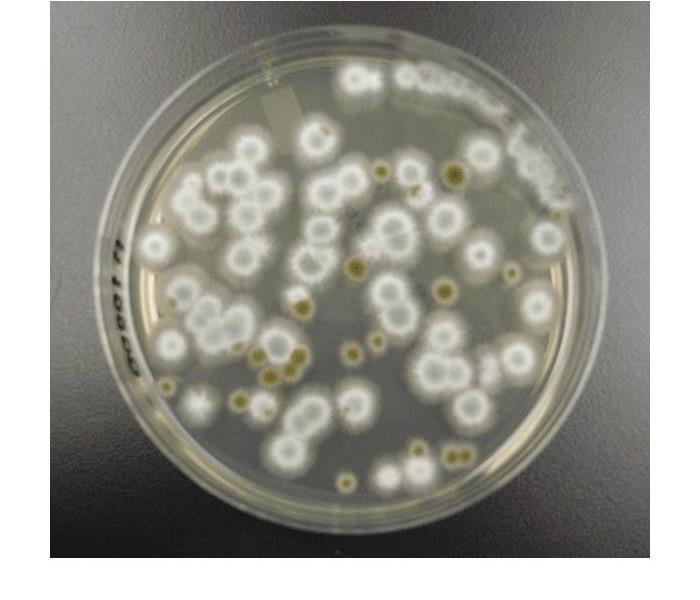Recent Mold Remediation Posts
Mold Grow on Concrete and Cement
9/15/2022 (Permalink)
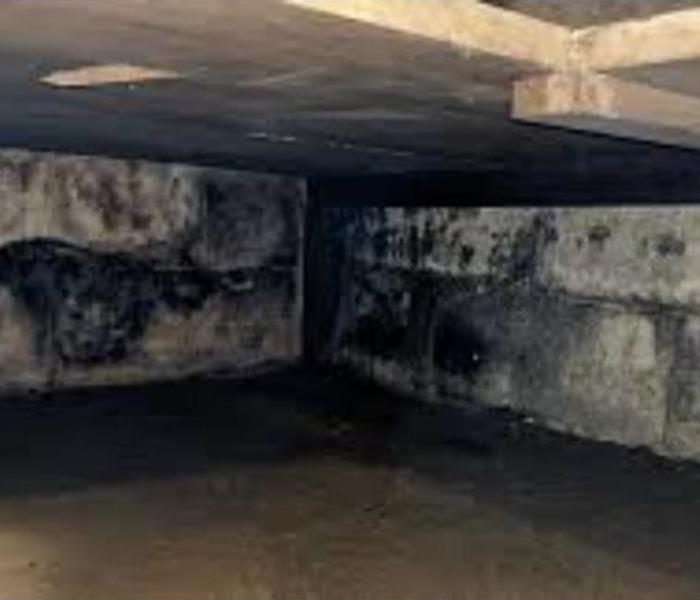 Unfortunately, concrete and cement surfaces are not mold-proof.
Unfortunately, concrete and cement surfaces are not mold-proof.
What Does Mold on Concrete Look Like?
On concrete or cement surfaces, mold will often appear as black, green, brown, or white. It may look like staining, or it might be fuzzy or raised. Sometimes, mold will look like algae or moss.
Over time, mold will break down the material it’s growing on. Assuming ideal mold-growing conditions are maintained, and the mold remains unmitigated, surfaces like concrete can quickly become compromised.
Efflorescence vs. Mold
Not all staining is caused by mold. For example, efflorescence is a white deposit left behind on surface materials when water evaporates and is often mistaken for a white mold. Efflorescence can be dissolved or wiped away while staining from mold would need to be scraped or scrubbed off the concrete.
How to Get Mold off Concrete
If you suspect mold on cement or concrete in your home, contact a professional remediation service provider. Mold is not only difficult to remove, but it can be a danger to your health. Further, without professional water damage restoration, you run the risk of repeat mold growth.
After you’ve discovered mold on a concrete surface, we recommend:
Sealing off the room (if possible).
Contact SERVPRO of Streamwood, Bartlett, West Chicago, and Warrenville
Once our team has arrived at your home, we’ll:
Inspect the area and confirm the presence of mold.
Contain the space and begin the mold removal process.
Ensure the space is completely dry and address the underlying cause of the mold (often plumbing, drainage, or high humidity).
Apply a penetrating concrete sealant to prevent a recurrence.
How to Prevent Mold on Concrete
Take steps to prevent mold growth on concrete and cement surfaces inside your home, including slab foundations and block walls. Common precautions include:
Monitoring your basement, crawlspace, and garage for signs of water damage: Mold can’t grow without a source of moisture. Be vigilant and engage in professional water damage restoration at the first sign of damage.
What are the Different Types of Mold?
9/1/2022 (Permalink)
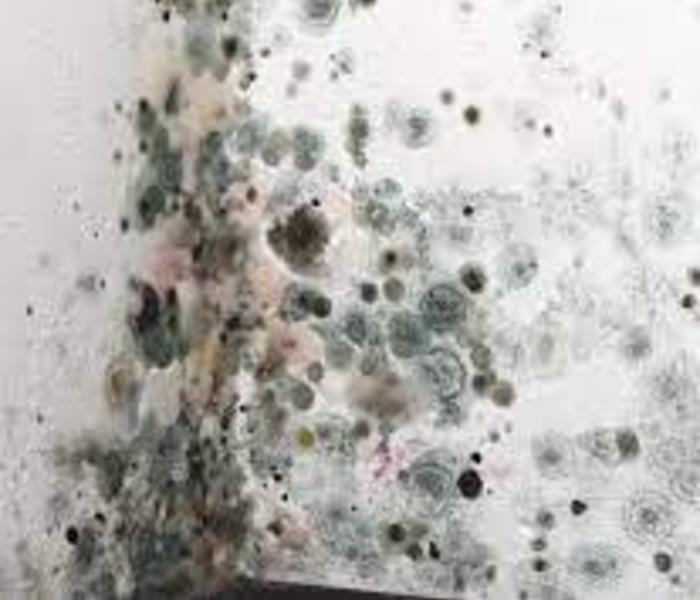 Homeowners should address any mold issues as soon as possible.
Homeowners should address any mold issues as soon as possible.
You might assume that all mold is the same. But mold, like all life forms, is incredibly diverse and comes in many different shapes and colors. Like birds, bugs, fish, and mammals, there is a diverse range of life in the mold family tree.
Here are a few types that are a particular concern for homeowners.
Stachybotrys
This type of mold grows extremely well on wood, hay, paper, and cardboard. This is the type that is commonly called “black mold” or “toxic mold” although these are unofficial terms that are often used to describe different molds. Stachybotrys mold usually requires extremely damp conditions with days or even weeks to fully grow.
Toxic molds, also known as mycotoxins, can also be found in office buildings. We see this in offices with poor ventilation and indoor water source like a fountain. While water indoors may look pretty, if there is not proper ventilation as well as temperature and humidity control, it can be a breeding ground for black toxic mold.
Aspergillus
Aspergillus mold is one of the most common forms of household mold. It has 185 different sub-species with 22 sub-species known to cause illness.
Cladosporium
This is also a common form of mold that has a pretty ugly reputation. Cladosporium a genus of fungi including some of the most common indoor and outdoor molds. Species produce olive-green to brown or black colonies, and have dark-pigmented conidia that are formed in simple or branching chains. Many species of Cladosporium are commonly found on living and dead plant material.
Mucor
This type of mold is actually common in soils, but it can work its way into homes. Mucor mold is often found in duct work and inside air conditioning systems. It grows fast, has a whitish or grey color, and can grow quite thick.
Penicillium Mold
Anyone who’s studied medicine knows that penicillin is commonly used as an antibiotic against various types of infections. It can grow on walls and many types of food, and it’s actually used quite often in food processing.
Acremonium
Acremonium is a group of molds that can frequently be found indoors and several of its species are known human pathogens.Fusarium
This is another common soil mold that usually affects humidifiers and plants. It can produce toxins that could be harmful to circulatory and nervous systems. If this mold does affect someone, it’s usually through ingestion (such as eating contaminated grains), but it is not unheard of for people to inhale the spores.
WHAT DOES MOLD NEED TO GROW?
9/21/2021 (Permalink)
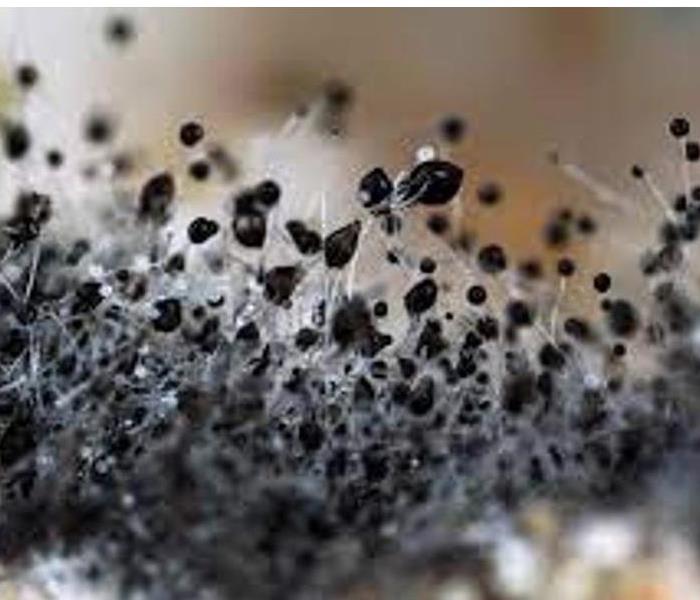 Without the following six things, mold is unable to grow.
Without the following six things, mold is unable to grow.
Without the following six things, mold is unable to grow. When reading this information, carefully consider the environment in your home and whether or not it’s ideal for mold growth.
We’ve also included steps you can take at each point to fix these problems so that mold can’t grow in your home.
1. MOISTURE
Mold is a living thing, which means it needs moisture to survive. In most cases, this is the biggest factor in determining whether or not mold grows in a home since many of the other items on this list are unavoidable.
In a home, moisture can come from a number of sources. Getting to the root of the problem is vital to solving it. For example, if you have a leaking pipe under your home, you need to have that fixed or the moisture is going to continue happening even if you replace the wet walls. If your home has been flooded, one of the first things you need to do is get it dry before mold starts to grow.
Something small you can do to avoid a buildup of moisture in your home is to squeegee and towel dry your sinks and shower after using them. This is one of the simplest steps you can take to prevent mold growth in your home.
2. OXYGEN
Another thing mold needs to grow is oxygen. Unfortunately, there’s nothing you can really do to prevent your home from having oxygen in it. What you need to recognize, however, is that oxygen can fit through even the tiniest of spaces. You want to ensure your home is completely sealed from the outside. This means having high-quality insulation that keeps all air from getting into your walls where mold can grow unseen.
3. FOOD
Without a food source, mold can’t grow. Mold can feed on a number of things, including meat and vegetables, drywall, material, and wood. There are a couple of things you can do to avoid feeding the mold in your home.
First of all, maintaining a clean home free of food waste will prevent mold from growing on your kitchen counter, under your couch, and in your refrigerator. Limit eating to only areas of the home with hard flooring and clean them daily.
4. DARKNESS
Ultraviolet (UV) light from the sun kills most mold and spores, which is why you don’t see it growing outside in the open. That also means when you’re looking for mold, you’ll need to check dark nooks and crannies where it might be hiding.
This is something else that you can’t prevent unless you install UV bulbs in every part of your home to completely light it up all the time. But that would be expensive and impossible to maintain. Instead, use this as a warning to pay special attention to areas that are dark in your home. Those are the ones that need to be kept dry and free from mold food sources more than areas that get natural sunlight.
5. WARMTH
The last thing mold needs for an ideal environment is warmth. This just means temperatures above freezing, which is why you may see mold in your refrigerator but won’t see it in your freezer unless it’s not working.
Mold grows fastest in temperatures above 60 degrees. Since your home should always be above 60 degrees, it means that mold can grow inside year-round. We don’t recommend shutting off your furnace to prevent or stop mold growth since that can lead to some other serious problems, but we do recommend paying attention to those places where mold may grow even in the winter.
You’ll also want to be extra diligent in the summer months. As the temperature gets higher, mold can grow even faster. There are also more mold spores in the summer months because they’re thriving outside.
6. MOLD SPORES
Something you may not have thought about is the fact that for mold to grow, spores must be present. Mold is similar to a plant in that it sends seeds out into the world to reproduce. The truth is that mold spores are already floating around in the air outside and inside of your home. However, with nowhere ideal to latch onto, they quickly die and won’t grow.
Can Mold Come Back After Remediation?
9/1/2021 (Permalink)
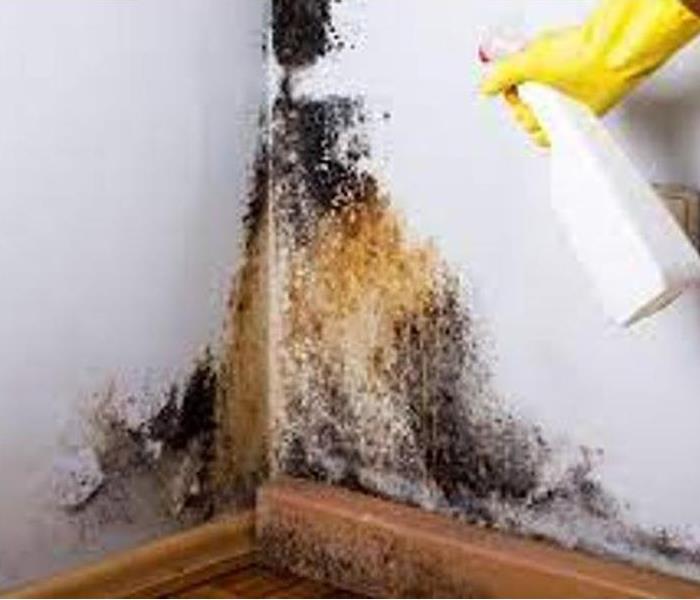 There are many important things to remember when it comes to mold removal.
There are many important things to remember when it comes to mold removal.
Mold can only come back after remediation, if …
- There is a brand new water intrusion (roof leak, HVAC dripping, plumbing issues, standing water)
- Your AC is not cooling properly and at an acceptable temperature
- Relative humidity in the home is over 50%
- Wet towels or clothing is left balled up for long periods of time
- Air circulation is not adequate in small spaces
- Mold remediation was not performed properly or in its entirety
- You bring mold infected items into your clean environment
It is important to remember that mold needs 2 things to grow:
- A food source (drywall, insulation, wood, etc)
- Moisture (leak or lack of ventilation)
Good rules of thumb to keep mold from returning:
- Keep your AC running at 76 degrees or lower
- Refrain from hanging or balling up wet items
- Call SERVPRO of Streamwood, Bartlett, West Chicago, & Warrenville right away if you have a leak or smell mustiness
- Never turn your AC off when the home is not occupied
- Get on an AC maintenance plan
- Run ventilation fan or keep the bathroom dry during and after showering (temporarily)
- Run a dehumidifier daily if you have high humidity (living on the ocean or river)
- Limit or eliminate keeping live plants in your home
Word to the Wise: You cannot simply wipe down or paint over mold.
It is imperative that the mold is properly cleaned and that the area is dried out thoroughly. Make sure that all wet areas in your home are properly treated by a professional to avoid the return and regrowth of mold.
Spores can grow in just 48 hours, so make sure to address any needed home repairs immediately.
Mold loves leather, wicker, and wallpaper. These materials are some of the most challenging to rid of the mold due to what they are made of. Same with popcorn ceilings.
The more porous the material, the harder it is to clean. The more mold-affected items that you can dispose of, the better. If you can live without it, let it go.
BLACK MOLD: How It Can Form
9/10/2020 (Permalink)
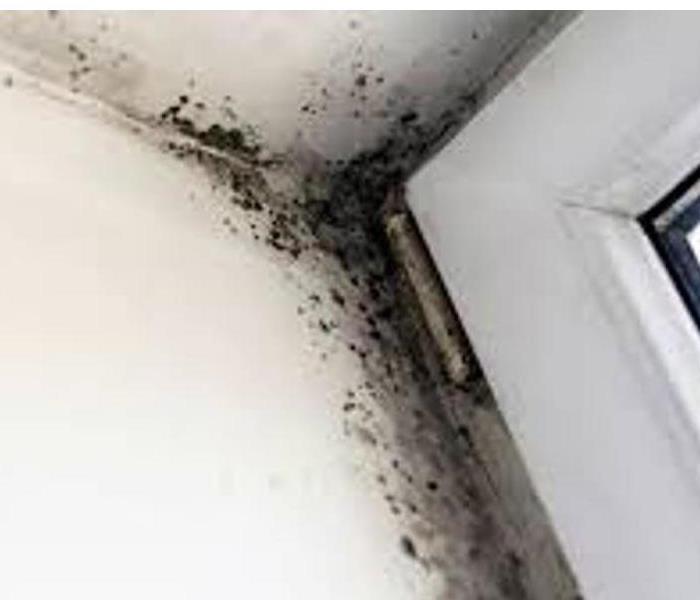 Black mold can cause many different problems in your home and health.
Black mold can cause many different problems in your home and health.
Has the musty smell of decay ever hit you when you walked into a bathroom? Chances are that the bathroom had suffered water damage at some point and mold growing behind the walls caused the musty smell. In its natural environment, meaning outside, mold isn’t much of a problem. In nature, mold serves a useful purpose; specifically, it breaks down dead leaves and other organic matter. However, in your home, mold can damage your walls and sheetrock and can even be a danger to your health.
Any type of mold in your home is going to be bad for its structural integrity.
Mold can begin growing in your home in any environment that contains excessive moisture. This most frequently occurs when you have a leaking pipe.
Once a pipe has begun to leak, it is essential to stop it as soon as possible to prevent your family from feeling any ill effects on their health from mold. One of the quickest ways to stop a very small leak while you wait for a plumber is to wrap duct or electrical tape around the leaky pipe. But that is no permanent fix. If you feel like doing a bit more thorough job, you can use a pipe clamp. You will want to select a clamp that is the correct size for the pipe. Then, clean the pipe and wrap it in a rubber pad. Secure the pipe clamp securely over the rubber and you have a quick fix!
Mold Prevention Tips for your Home
9/2/2020 (Permalink)
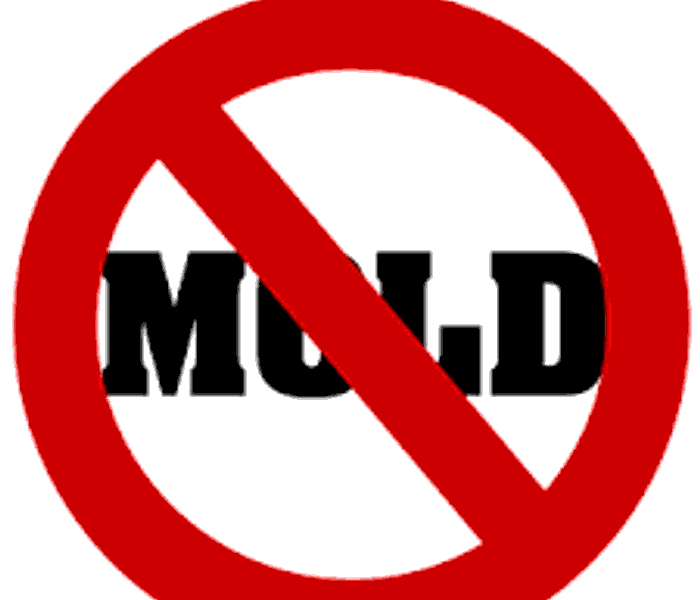 Helpful hints to prevent mold growth in your home
Helpful hints to prevent mold growth in your home
1. Keep Healthy Humidity Levels
Mold and mildew thrive in a humid environment, so it is important to keep your humidity levels down. In areas that are prone to excessive moisture, make sure you ventilate. When using the kitchen, bathroom, or basement, turn on thevent fans. If there are no vent fans in these rooms, have them repaired or installed by an electrician. Also, consider installing whole-home humidification or plug-in dehumidifiers.
Attics fans can also help manage moisture and provide ventilation in the home. Ask your HVAC professional if attic fans are right for your home.
You can also take measures to control the humidity levels in your home with your HVAC system, which may or may not have a humidification system built-in. Regardless, running the air conditioner will help dry and circulate the air. A closed-up home in the summer without air conditioning and little air movement will create the humid, warm, and dark conditions necessary for mold growth.
2. Fresh Air
Open windows help increase the ventilation in your home – and are a good way to lower indoor carbon dioxide levels. High carbon dioxide levels can cause decreasing oxygen levels in the body, hampering the flow of oxygen to the brain. If your home has been closed up for several months, carbon dioxide can build up, especially in rooms where people spend the most time. Fresh air will also help dry out damp, musty areas and reduce odors and stuffiness. Every day, open up a window or two for 5-15 minutes to provide some free, natural ventilation to your home.
3. Use Green Cleaning Products
Cleaning products with an overwhelming odor are ironically the biggest sources ofvolatile organic compounds (VOCs) in the home. This is especially true of artificial pine and lemon products. When using these cleaners to rid areas of mold and other pollutants, you are essentially trading one contaminant for another. When dealing with mold (and cleaning your home in general), try to stick with cleaners that are water-based, non-toxic, and non-aerosol.
4. Dry Wet Areas
Although you should avoid toxic cleaners, that doesn’t mean you shouldn’t regularly clean the surfaces in your home. Getting into the habit of cleaning and drying the surfaces in your bathroom and other moist areas is a great way to keep your bathroom clean and free of mold and mildew.
Mold can’t grow and thrive without moisture, so it’s important to dry wet areas in your home immediately. A leaky pipe, a damp basement, and even a spill on your carpet needs to be dried thoroughly and as quickly as possible (within 24 hours). Also, make sure you don’t leave wet clothing or bath towels out for too long. It is very difficult to completely clean material that has been compromised by mold.
Fix any plumbing leaks or water issues to remove the sources of moisture in your home. Some waterproofing solutions include:
- Cleaning and repairing gutter and downspout systems
- Installing and maintaining a basement sump pump.
- Sealing window and foundation leaks
- Improving drainage by repairing lots, unblocking sewers, and installing new drainage systems.
- Repairing leaks as soon as you find them
Mold Remediation Appointment
6/7/2018 (Permalink)
We are available 24 hours per day. Before your appointment, be sure to:
- Inventory damaged and missing goods for your insurance claim.
- Throw away all sealed and unsealed food and beverage contacted by storm flood waters.
- Open windows and doors.
- Refrain from using electrical devices until it is safe.
- Remove standing water when possible.
- Use dehumidifiers and fans to ventilate your home; SERVPRO of Kendall County can perform this task upon arrival.This list includes
- Carpet, carpet padding, ceiling tiles, clothing, drywall, floor tiles, insulation, leather goods, paper, upholstery, wallpaper and wood items. When our mold remediation expert arrives, he will:
- Our mold remediation technicians will also determine if any contents in your home are salvageable. Porous items that are wet for over 48 hours and cannot be completely dried and cleaned must be disposed of.
- Apply biocides.
- Decide whether or not you can stay in your house during the mold remediation process.
- Determine if additional ventilation and containment is needed.
- Look for mold in the HVAC system and biological hazards in the home.
- Test for any additional mold after the mold remediation process.
- Use quick structural drying techniques.
Finding Mold
5/31/2018 (Permalink)
At times, mold is hard to find. What usually happens is that mold grows in a place that never dried out. A combination of moisture, a warm temperature and an organic food source create the perfect environment for mold to grow quickly, so Bartlett/ Streamwood area is a perfect spot for mold growth with the high humidity and warm spring and summer days. Mold spores are everywhere and can easily get into homes and businesses. Here are some tips to avoid mold growth in your home:
-Do not allow standing water in or around your home
-Leave the AC Unit running when you are not at home
-Use exhaust fans in your home, especially in the bathroom
-If you notice any strange smells, investigate immediately
-Don't forget to call your local remediation, SERVPRO of Streamwood/ Bartlett/ West Chicago City, at 630-562-9212 if you think mold may be an issue you are facing in your home
Mold is Everywhere
5/31/2018 (Permalink)
Mold Fact #1: Mold is everywhere, no matter what you try to do.
Bits of mold are part of the air you breathe everywhere you go. Molds grow on plants and in soil, float off into the air, and float in through your doors and windows. You’ve been dealing with it all your life and there is usually no way (except in very special circumstances) to create a space with no mold in the air.
Mold Fact #2: Large areas of mold should really be dealt with by a professional.
When mold areas get larger than about 10 square feet (about a square meter) or you don’t know the extent of the problem (for instance: mold can grow behind the walls) it is important to bring in a professional, like SERVPRO of Streamwood/ Bartlett/ West Chicago City, who is familiar with how to deal with mold properly. This sized area usually requires extra precautions when removing mold. Much larger areas of mold can require very complicated procedures and precautions.
Mold Fact #3: Stains and mysterious spots are not always mold.
Sometimes a black, brown, grey, or white spot isn’t actually mold. Efflorescence, for instance, is a whitish deposit, especially on concrete or rocks. That happens when water permeates the material and leaves behind a deposit of salts. Note, however, that in this case there is water permeation, which may mean there is mold growing where you don’t see it. Other spots can be caused by soot or soil deposits, giving a darker color. If you want to know what you’re looking at, you can collect samples yourselves and send them to mold laboratories that can test air samples or pieces of material and tell you whether you have mold or not.
Mold in your Home
5/31/2018 (Permalink)
It is not uncommon to discover mold in homes in the Streamwood/ Bartlett areas. Mold tends to grow in damp or humid spots with poor air circulation such as bathrooms, laundry rooms, or attics and basements.
Often times a small area of surface mold is a problem the homeowner can safely handle themselves with a diluted bleach solution of no more than 1 part bleach to 10 parts water. The Center for Disease Control has outlined a fairly comprehensive strategy for in-home mold remediation. However, their article recommends that homeowners should not attempt a mold remediation of more than 10 square feet by themselves. Anything over that limit requires professional attention by IICRC Certified mold remediation technicians, like SERVPRO of Streamwood/ Bartlett/ West Chicago City. If you want to know what you’re looking at, you can collect samples yourselves and send them to mold laboratories that can test air samples or pieces of material and tell you whether you have mold or not.
Our highly trained and certified technicians consider what the source of the moisture is - making sure to dry the affected area completely to prevent further mold growth in the future. We take appropriate measures, such as plastic containment, negative air pressure, and High-Efficiency Particulate Air filtering to prevent further contamination of the home by mold spores that may become airborne during the remediation.
What Can I Do to Prevent Mold From Growing in My Home?
5/31/2018 (Permalink)
Since mold needs a food source, warmth and moisture to grow, the best thing you can do is to prevent moisture problems that allow mold to grow.
- Maintain lower levels of humidity in your home (preferably between 30-50%) by: venting bathrooms and dryers to the outside; using air conditioners and de-humidifiers; increasing ventilation by adding crawlspace and attic vents; using exhaust fans when cooking, dishwashing, showering and cleaning, etc.
- Add insulation to reduce the potential for condensation on cold surfaces such as windows, pipes, exterior walls, roofs, or floors.
- Inspect your home regularly for indications and sources of indoor moisture such as leaking pipes, appliance hoses, showers, tubs, sinks and toilets. Replace plastic hoses with steel-reinforced hoses. Check windows, doors, attics and ceilings for leaks or evidence of water stains or odors, particularly after rains. Fix plumbing issues, and roof leaks right away.
- Don't carpet bathrooms, basements, kitchens or other areas prone to moisture. Clean bathrooms often and keep surfaces dry.
- Cover dirt in crawlspaces with a moisture barrier plastic sheeting.
- Prevent water from entering basements and crawlspaces by repairing holes and cracks in walls and foundation. Use landscaping to direct water away from your foundation.
- Clean and maintain your gutters and make sure drainpipes carry water several feet away from your home.
- Watch your utility bills. An abnormally high water bill could signal a water leak.
- Before you travel, turn off the water at the main valve. Have a trusted friend or neighbor check the inside and outside of your home periodically while you're away.
If you think you may have a mold issue or signs of mold growth in your home call SERVPRO of Streamwood/ Bartlett/ West Chicago City at 630-562-9212
IICRC Certified
5/30/2018 (Permalink)
Mold has been around forever because mold is a naturally occurring microscopic fungi that can be found almost anywhere. However, you don't want it in your home or business. SERVPRO of Streamwood/ Bartlett/ West Chicago City is your local certified Mold Remediation Company.
Here are a few key years regarding the history of mold awareness.
- 2001 Environmental Protection Agency (EPA) Guidelines for Schools and Commercial Buildings (www.epa.gov)
- 2003 OSHA Safety and Health Information Bulletin
- 2003 IICRC Standard and Reference Guide for Professional Mold Remediation (S520) (www.IICRC.org/s520info.shtml )
- 2006 National Indoor Mold Society is formed (http://afamerica.com/nims/)
- 2008 IICRC Standard and Reference Guide (S520) 2nd Edition is released
- 2009 EPA Designates September as National Indoor Toxic Mold Awareness Month
Litigation Prior to 1993 Was Limited:
- Initial cases were:
- Landlord-tenant
- Faulty construction
- Lawsuits are in state and federal court
- Regulatory Organizations such as State Health Agencies, State Attorney Generals and the outcome of litigation are defining the future of how we conduct mold mitigation and remediation and how mold liability is handled.
SERVPRO of Streamwood/ Bartlett/ West Chicago City requires that our technicians become certified through the Institute of Inspection Cleaning and Restoration Certification (IICRC). The IICRC S520 Standard and Reference Guide for Professional Mold Remediation.
Call SERVPRO of Streamwood/ Bartlett/ West Chicago City today for any and all mold questions or concerns. 630-562-9212





 24/7 Emergency Service
24/7 Emergency Service






